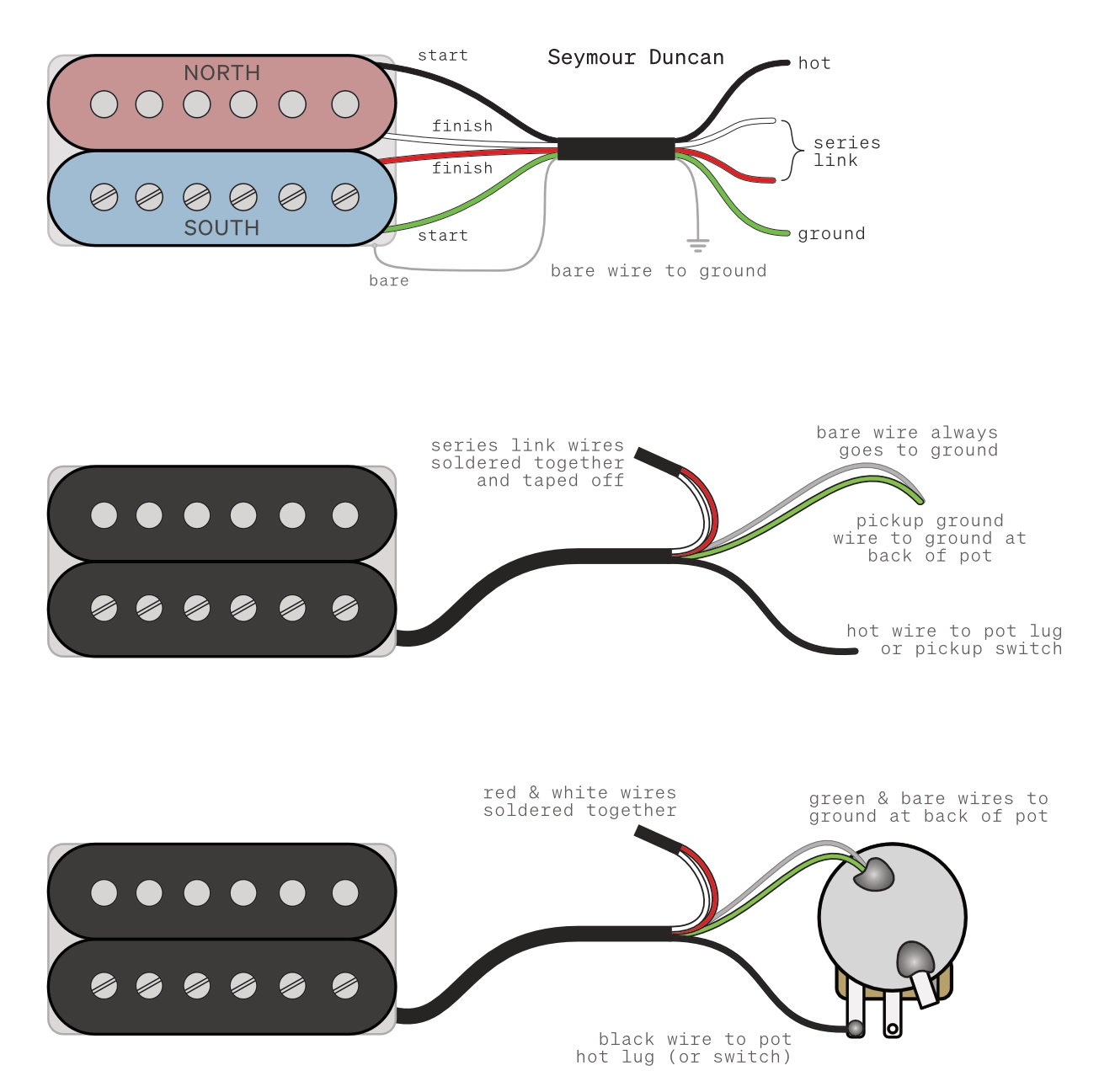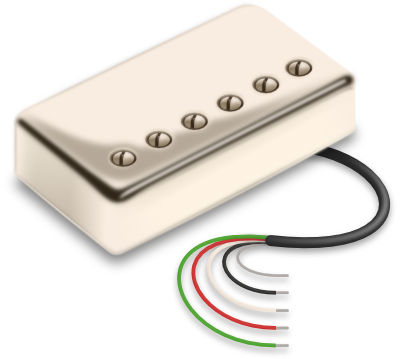Wiring Info
This site isn't intended to teach you how to solder or wire a guitar. You'll find resources around the internet for that if you poke about (or you could check out my book). However, here are a few things worth keeping in mind as you use this site to swap out one pickup for another.
Diagrams to real-life
The guitar pickup wiring diagrams on this site are somewhat stylised in order to provide more information about what wire goes where inside and outside the pickup. Here's how they relate to the real-life pickups. We'll take a Seymour Duncan pickup as an example.

Humbucker Wire Colours
Let's look at the standard humbucker wiring and how that would work out if you were installing a pickup in your guitar.
Series-Link
Those two wires labelled as series link… Unless we're splitting coils or doing some fancy wiring, those need to be soldered together and insulated with tape or heat-shrink tubing. For a standard humbucker operation, they just serve to connect one coil to the other and can be joined, insulated, and ignored. In our case with the Seymour Duncan pickup, that's the red and white wires.
Hot
The wire labelled hot will usually go to either the pickup selector switch or to a lug on a volume pot (depending on the guitar). For the Duncan humbucker, that's the black wire.
Ground
The wire labelled ground will typically connect to a common ground point. Most of the time, that's the back of a pot case.
Bare wire
The bare wire will always connect to a ground point. That means that, for a four-wire humbucker, you'll usually have the bare wire and the ground wire soldered to a pot case. For our Seymour Duncan pickup install, that will mean the bare wire and the green wire are both soldered to the pot.
Four-wire, three-wire, generic pickups and more
Most of the confusion around pickup wire colours centres on four-wire pickups. Actually, these are probably better referred to as 'four-wire-plus-bare' pickups since you've got four coloured wires and a bare shield wire. These are mostly what is shown on this site.
Some pickups may have three wires (and bare/shield). This can happen when, instead of bringing out both of the series link wires, these are joined internally in the pickup and a single wire brought out from that join point. These aren’t as flexible for doing stuff like series-parallel switching but that single series-link wire can still be used to split the coils.
If the pickup has a braided outer sheath, it always goes to ground. Sometimes this serves as the pickup ground wire as well as the shield wire and you’ll find only one wire within the braid (that'll be the hot). Occasionally though, you’ll have different numbers of wires inside the braid. If there are two wires inside the braid, one is probably the pickup coil ground and the other will be the hot. Sometimes though, one will be hot and the other will be series-link. Usually. If there are three, one is probably pickup coil ground, one is series-link, and the other is hot.
I've included some 'generic' pickups with different numbers of hook-up wires to try illustrate how these compare to other pickups. Their wiring colours and assignments can vary so sometimes you may have to guess. It's usually safe to assume the black wire is ground on these (but not always — I'm looking at you, PRS). Expect to do a little experimentation if you encounter them.
Better yet, check online (or buy my book) to find out how to test pickups with a multimeter to determine which wire does what.
Single-coil
Single coil pickups aren’t really shown here. Those like Strat pickups generally just have two hook-up wires — a hot and a ground (ground wire is usually black). Much of the time, you can connect these and see if it’s in phase. If it is, great. If it’s not, flip the wires. It’s usually that simple.
For pickups with a metal cover or baseplate, like a Tele, Jaguar, etc.) one wire will do double-duty as the pickup ground and the shield ground. You can’t just flip those wires or you’ll make the shield hot and that will be incredibly noisy. In the event that these are out of phase, you’ll either have to flip the other pickup or mod the new pickup to separate pickup ground from the shield wire.
Pickups like Seymour Duncan’s Hot Rails, that look like single coils but still have four wires, are really humbuckers shrunken down to single coil size. You can use the appropriate humbucker diagram for them (so for that Duncan Hot Rails example, you’d just pick the Seymour Duncan diagram).

If this site has saved you some hassle, it'd be cool if you could buy me a coffee.

